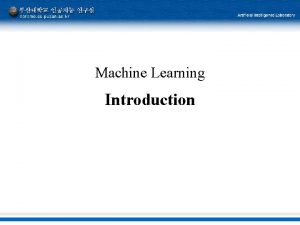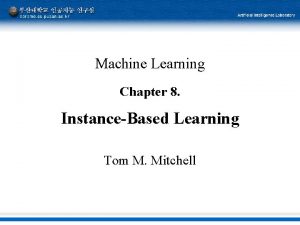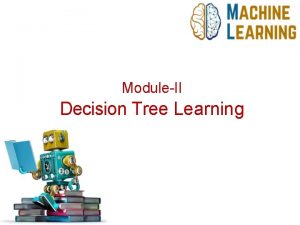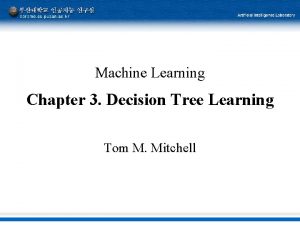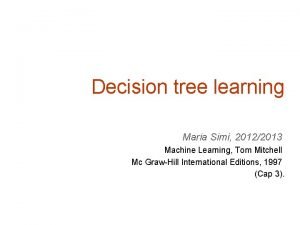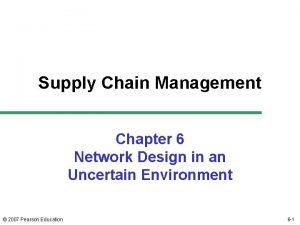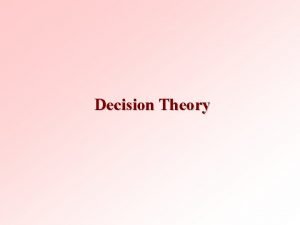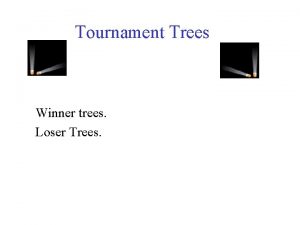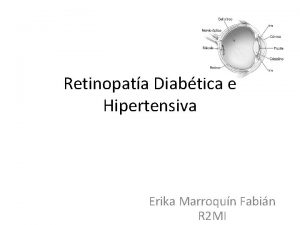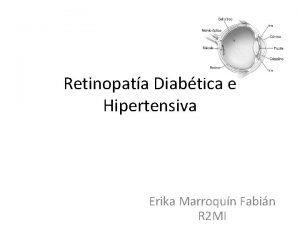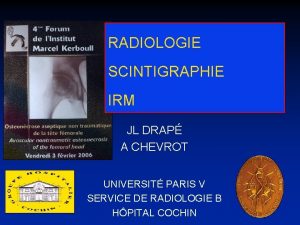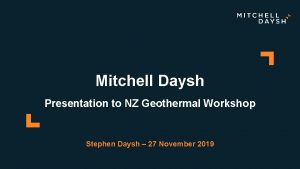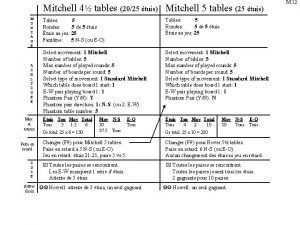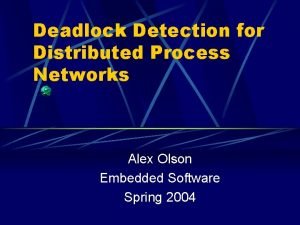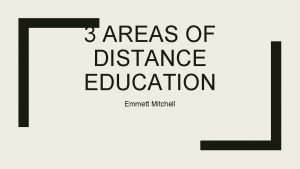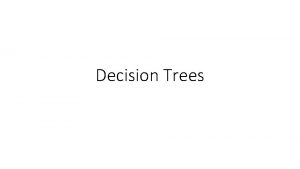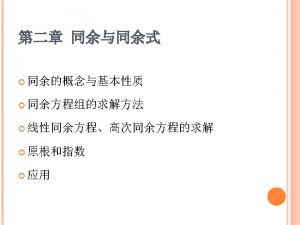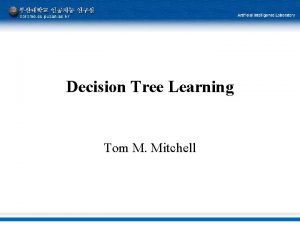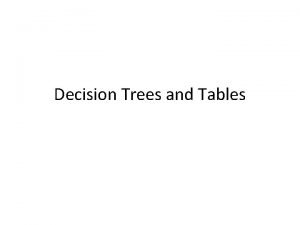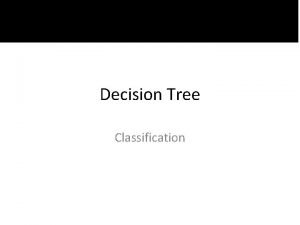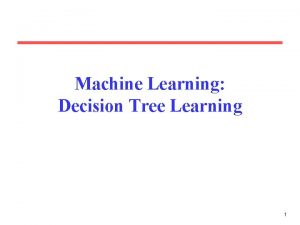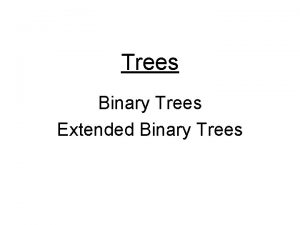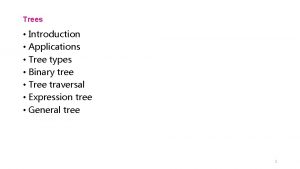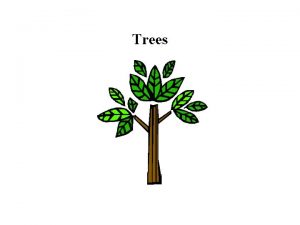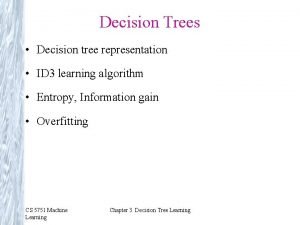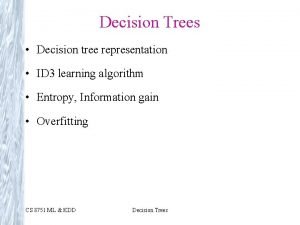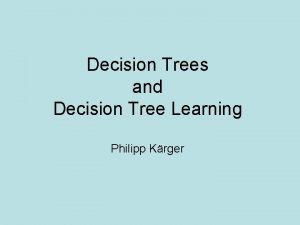Decision Tree Learning Learning Decision Trees Mitchell 1997










![Decision Tree Learning • Let’s Try an Example! • Let – E([X+, Y-]) represent Decision Tree Learning • Let’s Try an Example! • Let – E([X+, Y-]) represent](https://slidetodoc.com/presentation_image/05ee8f479aaa85846bd87e74b63af9bc/image-11.jpg)



















- Slides: 30

Decision Tree Learning • Learning Decision Trees (Mitchell 1997, Russell & Norvig 2003) – Decision tree induction is a simple but powerful learning paradigm. In this method a set of training examples is broken down into smaller and smaller subsets while at the same time an associated decision tree get incrementally developed. At the end of the learning process, a decision tree covering the training set is returned. – The decision tree can be thought of as a set sentences (in Disjunctive Normal Form) written propositional logic. – Some characteristics of problems that are well suited to Decision Tree Learning are: • • Attribute-value paired elements Discrete target function Disjunctive descriptions (of target function) Works well with missing or erroneous training data

Berkeley Chapter 18, p. 13

Berkeley Chapter 18, p. 14

Berkeley Chapter 18, p. 14

Berkeley Chapter 18, p. 15

Berkeley Chapter 18, p. 20

Decision Tree Learning (Outlook = Sunny Humidity = Normal) (Outlook = Overcast) (Outlook = Rain Wind = Weak) [See: Tom M. Mitchell, Machine Learning, Mc. Graw-Hill, 1997]

Decision Tree Learning Day Outlook Temperature Humidity Wind Play. Tennis D 1 D 2 D 3 D 4 D 5 D 6 D 7 D 8 D 9 D 10 Sunny Overcast Rain Overcast Sunny Rain Hot Hot Mild Cool Mild High Normal High Normal Weak Strong Weak Weak No No Yes Yes No Yes D 11 Sunny Mild Normal Strong Yes D 12 Overcast Mild High Strong Yes D 13 Overcast Hot Normal Weak Yes D 14 Rain Mild High Strong No [See: Tom M. Mitchell, Machine Learning, Mc. Graw-Hill, 1997]

Decision Tree Learning • Building a Decision Tree 1. 2. 3. 4. First test all attributes and select the one that would function as the best root; Break-up the training set into subsets based on the branches of the root node; Test the remaining attributes to see which ones fit best underneath the branches of the root node; Continue this process for all other branches until a. b. c. all examples of a subset are of one type there are no examples left (return majority classification of the parent) there are no more attributes left (default value should be majority classification)

Decision Tree Learning • Determining which attribute is best (Entropy & Gain) • Entropy (E) is the minimum number of bits needed in order to classify an arbitrary example as yes or no • E(S) = ci=1 –pi log 2 pi , – Where S is a set of training examples, – c is the number of classes, and – pi is the proportion of the training set that is of class i • For our entropy equation 0 log 2 0 = 0 • The information gain G(S, A) where A is an attribute • G(S, A) E(S) - v in Values(A) (|Sv| / |S|) * E(Sv)
![Decision Tree Learning Lets Try an Example Let EX Y represent Decision Tree Learning • Let’s Try an Example! • Let – E([X+, Y-]) represent](https://slidetodoc.com/presentation_image/05ee8f479aaa85846bd87e74b63af9bc/image-11.jpg)
Decision Tree Learning • Let’s Try an Example! • Let – E([X+, Y-]) represent that there are X positive training elements and Y negative elements. • Therefore the Entropy for the training data, E(S), can be represented as E([9+, 5 -]) because of the 14 training examples 9 of them are yes and 5 of them are no.

Decision Tree Learning: A Simple Example • Let’s start off by calculating the Entropy of the Training Set. • E(S) = E([9+, 5 -]) = (-9/14 log 2 9/14) + (-5/14 log 2 5/14) • = 0. 94

Decision Tree Learning: A Simple Example • Next we will need to calculate the information gain G(S, A) for each attribute A where A is taken from the set {Outlook, Temperature, Humidity, Wind}.

Decision Tree Learning: A Simple Example • The information gain for Outlook is: – G(S, Outlook) = E(S) – [5/14 * E(Outlook=sunny) + 4/14 * E(Outlook = overcast) + 5/14 * E(Outlook=rain)] – G(S, Outlook) = E([9+, 5 -]) – [5/14*E(2+, 3 -) + 4/14*E([4+, 0 -]) + 5/14*E([3+, 2 -])] – G(S, Outlook) = 0. 94 – [5/14*0. 971 + 4/14*0. 0 + 5/14*0. 971] – G(S, Outlook) = 0. 246

Decision Tree Learning: A Simple Example • G(S, Temperature) = 0. 94 – [4/14*E(Temperature=hot) + 6/14*E(Temperature=mild) + 4/14*E(Temperature=cool)] • G(S, Temperature) = 0. 94 – [4/14*E([2+, 2 -]) + 6/14*E([4+, 2 -]) + 4/14*E([3+, 1 -])] • G(S, Temperature) = 0. 94 – [4/14 + 6/14*0. 918 + 4/14*0. 811] • G(S, Temperature) = 0. 029

Decision Tree Learning: A Simple Example • G(S, Humidity) = 0. 94 – [7/14*E(Humidity=high) + 7/14*E(Humidity=normal)] • G(S, Humidity = 0. 94 – [7/14*E([3+, 4 -]) + 7/14*E([6+, 1])] • G(S, Humidity = 0. 94 – [7/14*0. 985 + 7/14*0. 592] • G(S, Humidity) = 0. 1515

Decision Tree Learning: A Simple Example • G(S, Wind) = 0. 94 – [8/14*0. 811 + 6/14*1. 00] • G(S, Wind) = 0. 048

Decision Tree Learning: A Simple Example • Outlook is our winner!

Decision Tree Learning: A Simple Example • Now that we have discovered the root of our decision tree we must now recursively find the nodes that should go below Sunny, Overcast, and Rain.

Decision Tree Learning: A Simple Example • G(Outlook=Rain, Humidity) = 0. 971 – [2/5*E(Outlook=Rain ^ Humidity=high) + 3/5*E(Outlook=Rain ^Humidity=normal] • G(Outlook=Rain, Humidity) = 0. 02 • G(Outlook=Rain, Wind) = 0. 971 - [3/5*0 + 2/5*0] • G(Outlook=Rain, Wind) = 0. 971

Decision Tree Learning: A Simple Example • Now our decision tree looks like:

Decision Trees: Other Issues • There a number of issues related to decision tree learning (Mitchell 1997): – Overfitting • Avoidance • Overfit Recovery (Post-Pruning) – Working with Continuous Valued Attributes – Other Methods for Attribute Selection – Working with Missing Values • Most common value at Node K • Value based on probability – Dealing with Attributes with Different Costs

Decision Tree Learning: Other Related Issues • Overfitting when our learning algorithm continues develop hypotheses that reduce training set error at the cost of an increased test set error. • According to Mitchell, a hypothesis, h, is said to overfit the training set, D, when there exists a hypothesis, h’, that outperforms h on the total distribution of instances that D is a subset of. • We can attempt to avoid overfitting by using a validation set. If we see that a subsequent tree reduces training set error but at the cost of an increased validation set error then we know we can stop growing the tree.

Decision Tree Learning: Reduced Error Pruning • In Reduced Error Pruning, – – Step 1. Grow the Decision Tree with respect to the Training Set, Step 2. Randomly Select and Remove a Node. Step 3. Replace the node with its majority classification. Step 4. If the performance of the modified tree is just as good or better on the validation set as the current tree then set the current tree equal to the modified tree. – While (not done) goto Step 2.

Decision Tree Learning: Other Related Issues • However the method of choice for preventing overfitting is to use post-pruning. • In post-pruning, we initially grow the tree based on the training set without concern for overfitting. • Once the tree has been developed we can prune part of it and see how the resulting tree performs on the validation set (composed of about 1/3 of the available training instances) • The two types of Post-Pruning Methods are: – Reduced Error Pruning, and – Rule Post-Pruning.

Decision Tree Learning: Rule Post-Pruning • In Rule Post-Pruning: – Step 1. Grow the Decision Tree with respect to the Training Set, – Step 2. Convert the tree into a set of rules. – Step 3. Remove antecedents that result in a reduction of the validation set error rate. – Step 4. Sort the resulting list of rules based on their accuracy and use this sorted list as a sequence for classifying unseen instances.

Decision Tree Learning: Rule Post-Pruning • Given the decision tree: • • • Rule 1: If (Outlook = sunny ^ Humidity = high ) Then No Rule 2: If (Outlook = sunny ^ Humidity = normal Then Yes Rule 3: If (Outlook = overcast) Then Yes Rule 4: If (Outlook = rain ^ Wind = strong) Then No Rule 5: If (Outlook = rain ^ Wind = weak) Then Yes

Decision Tree Learning: Other Methods for Attribute Selection • The information gain equation, G(S, A), presented earlier is biased toward attributes that have a large number of values over attributes that have a smaller number of values. • The ‘Super Attributes’ will easily be selected as the root, result in a broad tree that classifies perfectly but performs poorly on unseen instances. • We can penalize attributes with large numbers of values by using an alternative method for attribute selection, referred to as Gain. Ratio.

Decision Tree Learning: Using Gain. Ratio for Attribute Selection • Let Split. Information(S, A) = - vi=1 (|Si|/|S|) log 2 (|Si|/|S|), where v is the number of values of Attribute A. • Gain. Ratio(S, A) = G(S, A)/Split. Information(S, A)

Decision Tree Learning: Dealing with Attributes of Different Cost • Sometimes the best attribute for splitting the training elements is very costly. In order to make the overall decision process more cost effective we may wish to penalize the information gain of an attribute by its cost. – G’(S, A) = G(S, A)/Cost(A), – G’(S, A) = G(S, A)2/Cost(A) [see Mitchell 1997], – G’(S, A) = (2 G(S, A) – 1)/(Cost(A)+1)w [see Mitchell 1997]
 Mitchell 1997 machine learning
Mitchell 1997 machine learning No decision snap decision responsible decision
No decision snap decision responsible decision Investment decision financing decision dividend decision
Investment decision financing decision dividend decision Decision tree and decision table examples
Decision tree and decision table examples Machine learning tom
Machine learning tom Pac learning model in machine learning
Pac learning model in machine learning Reduced error pruning example
Reduced error pruning example Inductive bias in decision tree learning
Inductive bias in decision tree learning Decision tree machine learning andrew ng
Decision tree machine learning andrew ng Supply chain network design decisions include
Supply chain network design decisions include Decision making trees
Decision making trees Describe data and process modeling concepts and tools
Describe data and process modeling concepts and tools Winner tree
Winner tree Selection trees
Selection trees Winner tree
Winner tree Turbine banki cross-flow®
Turbine banki cross-flow® Nickole mitchell
Nickole mitchell Basil mitchell
Basil mitchell Mitchell1 social crm
Mitchell1 social crm Retinopatia hipertensiva clasificacion
Retinopatia hipertensiva clasificacion Fundo de olho retinopatia hipertensiva
Fundo de olho retinopatia hipertensiva Classification de mitchell ostéonécrose
Classification de mitchell ostéonécrose Stephen daysh
Stephen daysh 4 table mitchell movement
4 table mitchell movement Mitchell on demand pro
Mitchell on demand pro Michael c mitchell
Michael c mitchell Christina tripodi
Christina tripodi Mitchell merritt algorithm example
Mitchell merritt algorithm example Dr mitchell charap
Dr mitchell charap Emmett mitchell engineering
Emmett mitchell engineering Mitchell and cheeseman
Mitchell and cheeseman
